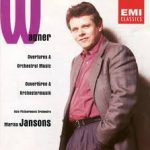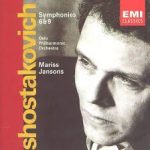The EMI Recordings- 1987-1997|Part Six
The year 1991
Shostakovich and Wagner
Like the year 1990, the year 1991 saw the Oslo Philharmonic produce two recordings for EMI. The first was in the early part of the year –if memory serves me correctly, we did this recording in late January 1991. These sessions were devoted to two Shostakovich symphonies – the Sixth, which is his Opus 54, and the Ninth, which is his Opus 70. We had previously recorded the Fifth Symphony in 1987, as the second recording for EMI. When it was announced that the Sixth and Ninth Symphonies were on the recording schedule, the thought crossed the minds of some of us in the orchestra that maybe this was to be part of a complete Shostakovich cycle. As it turned out, it was, but the recordings of these two symphonies that we made is part of a cycle that Mariss did for EMI with various orchestras. Our 1987 Fifth was eventually superseded by a Vienna Philharmonic recording which is included in the cycle. Sadly, our Fifth is no longer in print, which is sad, as there is a lot of energy and intensity in the performance. However, such are the ways of recording politics.
The second recording was planned for the period just after the orchestra returned from summer holiday, and it would be devoted to the music of Wagner. It would consist of several of the orchestral overtures and preludes, and some music from the “Ring”. Needless to say I was pretty much over the moon when the schedule was announced and began my mental preparations way before we even played the first note of either session. (I love the music of both Shostakovich and Wagner the way a meat lover loves a well-cooked steak!)
Shostakovich
The Shostakovich symphonies were (as I noted earlier) the first up. Sessions were scheduled for late January 1991. Normally, we would have played both of the symphonies in before the sessions, and that was the practice here as well. I believe the Sixth was played as part of separate concert, and the Ninth was part of a concert that included Scriabin’s “Le Poème de l’extase”. The reason I remember this program as that although we were to play the concert as a subscription pair, the second concert was cancelled due to the death of Norway’s King Olav V the night of the first concert. We had just finished the concert when news of his death was announced. All public events for the next couple of days were cancelled, although I remember that our recording sessions began on the Saturday following his passing.
The Sixth Symphony is very different than his 5th, although it contains many of the same elements that make Shostakovich great. The work is in three movements – a long, almost brooding first movement, and two shorter almost-but not-quite trite movements. One of these is a scherzo fully in the Shostakovich tradition, and the finale has an almost festive (circus-like) feel to it. Total length of the symphony is approximately thirty minutes.
The timpani part, as with most Shostakovich symphonies, is a challenge. The first movement features a passage near the end which is a quasi-solo; the harp doubles it, and both harpist and timpanist need to be in lock-step rhythmically and in terms of intonation. As the lower note of the solo was a B natural, I was a bit concerned as the 31 inch timpani normally would not reach B-natural, but the good Lord was smiling on me during this period as the head on that 31 inch reached the B natural and held it with ease. It was a particularly good head. The second and third movements have their challenges; the second movement has a solo passage on A and d with diminuendo and the last movement closes with a barrage of timpani on F#, B, and d#, requiring deft stick technique and good hands.
If memory serves me well (and as I get older I am not always so sure that it always does), brought out the 31 inch Light Continental chain drum for the first movement. I used it for the low F# in the first movement. Everything else was done on the Hinger timpani.
The Ninth Symphony is also unique in that is the second shortest of his symphonies in length (approximately twenty-six minutes in length); only the Second Symphony is shorter. It is also one of the composer’s more light-hearted works, which was unexpected, as most Ninth Symphonies were expected to be works of epic proportion, including chorus and soloists. That was the composer’s original intent, but he had second thoughts. It came out as the work we know and love today. Of course the Soviet music critics and governmental officials, expecting the epic work to celebrate the end of the war, were extremely critical, and it landed the composer in the doghouse (again), so to speak. Not epic enough.
Compared with other Shostakovich symphonies, the Ninth is comparatively straight-forward. There is not a lot of it, but it is fun to play and it has a lot of great tunes and work for the winds and brass.
The recording sessions went very well, and both works were on tape in the allotted time frame. John Fraser was the producer, assisted by Mark Vigars and the able Charles Almås of the NRK.
For mallets, I used my usual combination of Feldman and Hinger mallets – although more on the medium to hard side, along with a couple of pairs of bamboo-shafted mallets of medium hard category crafted for me by good friend and colleague, Harry Teahan, who was by now a member of the Trondheim Symphony. They worked very well and I was pleased with the results on the recording.
I did learn something about heads and overtones as a result of these sessions. In particular, I was not happy with the end of the Shostakovich Sixth. My articulations and stickings were spot on, but the d# was slightly sharper than I liked. I remember carefully tuning the drums, but for some reason, the mikes picked up a slight sharpness which bothered the heck out of me then (and still does). I never had the problem in subsequent outings with the symphony. I can only assume that I was not as vigilant as I thought. Oh well. Lesson learned.
Wagner
The recording sessions for the Wagner pieces were scheduled for August of 1991, just after the orchestra began its 1991-1992 season. Some of the pieces, such as the Prelude and Liebstod from “Tristan und Isolde” and the Prelude to Act III of “Lohengrin” and the “Ride of The Walkures” we had played many times and didn’t need to be programmed on a concert. The other works id, and a special Wagner/R.Strauss evening was programmed, including the Prelude to “Die Meistersinger”, Trauermarsch from “Götterdammerung”, and the Overture to “Rienzi”. The Richard Strauss portion (which was not to be recorded) included the Suite from Der Rosenkavalier” and the “Vier Letzte Lieder” with the amazing Jessye Norman as soloist. It was quite an evening.
The Hinger timpani were again the drums of choice, but I substituted the 22 and ½ inch out with the 24 inch Light Metropolitan B as I wanted a little more weight on the upper notes. I had by this time shifted the heads back to the Remo hazies on the Lights as the calfskin heads were giving out, and while it sounded good, I wished that I had waited a bit longer to make the change. Not that it sounded bad; it was more than acceptable, but I still hated to make the change, which was unfortunately necessary. The Lights, while sounding great with calf on good days, were very, very finicky. The Hingers were much more stable with calf, just the opposite of the Lights. I was never comfortable with the size of the 22 and an ½ inch on notes below f and f#. No matter; all came right in the end.
The sessions took place at our usual venue – the Oslo Konserthus – acoustically troublesome as it is. Our recording team was the same as for the Shostakovich sessions – producer John Fraser; Engineer Mark Vigars and NRK engineer Charles Almås. They did their usual good job and the sessions proceeded without any drama other than the music itself.
Wagner is one my all-time favorite composers and needless to say I was pumped up for these sessions (although not too pumped up as to lose my focus). For mallets, I used a mixture of Hingers and Feldmans along with a pair of 15 inch Hinger reds (with aluminum shafts). I mention these mallets as Dan gave them to me, saying that he had made them a while ago and loved to use them for music that needed some warmth and articulation. S a matter of fact, I used them for the Funeral Music from “Götterdammerung”. We used two players for this, although I played the solos. My colleague used the Light Metros (26” and 29”) and 31” Light Continental Chain drum. I am glad that we did it this way, as we got all the rhythms without one player switching from one part to another, and allowing for a better flow. The Prelude to Act I of “Die Meistersinger” has always been a favorite and I was careful not to overplay what is a very well-written part. I used the Hinger reds for this as well. I found myself playing much of the bass line in the early “Rienzi” overture. It has an impressive opening, but the later fast section, while fun to play and reflecting Wagner’s skills at the time he wrote it, is a bit blustery. The Overture to “Tannhäuser” was from the Dresden version of the opera, and also fun to play. I added a couple of F sharps – one low and one roll that should have been an “e”, but I changed to a high f sharp. Everyting else went well, and I still enjoy listening to this recording to this day.
All in all, a happy result for a great series of sessions.
Below are some links to what we played on these recordings. I hope you enjoy them as much as I had fun playing them!



Recent Comments